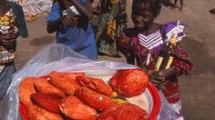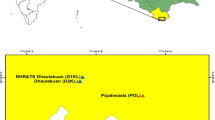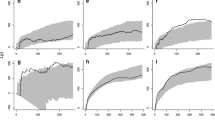Abstract
Thaumatococcus daniellii is a perennial African wild edible plant. Fruit arils from natural populations are the source of the protein sweetener, thaumatin. There are relatively few documented examples of its cultivation, however it has great potential as an intercrop for cultivation under rubber or cocoa. Across the species range there is notable diversity in leaf and fruit morphology. In this study, T. daniellii populations from four provenances in Ghana and Cameroon (separated by the Dahomey Gap) were compared for leaf and fruit morphology in situ and in an experiment using plants grown from sampled rhizomes planted under rubber in a single location in Cameroon. When collected rhizomes from four provenances were planted at one location, the samples from the local provenance produced the largest plants and fruits, and there was less morphological variation between samples from different provenances than was recorded in situ. In situ morphological differences were notable between north–south separated provenances in each country. Fruit collected in situ was analysed for aril thaumatin content and significant variation was found between provenances (1.08–2.00%). Amplified fragment length polymorphism (AFLP) was used to assess genetic diversity among the four provenances and 54% of loci were polymorphic. Cluster analysis of AFLP data separated samples of T. daniellii according to geographical origin. Maximum genetic diversity was found between provenances separated across the Dahomey Gap.





Similar content being viewed by others
References
Abbiw DK (1990) The useful plants of Ghana: West African uses of wild and cultivated plants. Intermediate Technology Publications/Royal Botanic Gardens, Kew
Andersson L (1998) Marantaceae. In: Kubitzki K, Huber PJ, Rudall PS, Stevens PS, Stützel T (eds) The families and genera of vascular plants: flowering plants—monocotyledons. Springer, Berlin, pp 278–293
Belaj A, Satovic Z, Cipriani G, Baldoni L, Testolin R, Rallo L, Trujillo I (2003) Comparative study of the discriminating capacity of RAPD, AFLP and SSR markers and of their effectiveness in establishing genetic relationships in olive. Theor Appl Genet 107:736–744
Booth AH (1958) The Niger, the Volta and the Dahomey Gap as geographic barriers. Evolution 12:48–62
Boy C, Waliszewski WS (2009) Extraction of thaumatin from Thaumatococcus daniellii arils. Protocol, Natex UK Ltd, Sandy
Cardoso SRS, Provan J, Lira CDF, Pereira LDOR, Ferreira PCG, Cardoso MA (2005) High levels of genetic structuring as a result of provenance fragmentation in the tropical tree species Caesalpinia echinata Lam. Biodivers Conserv 14:1047–1057
Chalmers K, Waugh R, Sprent J, Simons A, Powell W (1992) Detection of genetic variation between and within provenances of Gliricidia sepium and G. maculata using RAPD markers. Heredity 69:465–472
Chao CCT, Devanand PS, Chen JJ (2005) AFLP analysis of genetic relationships among Calathea species and cultivars. Plant Sci 168:1459–1469
Dhetchuvi MJB (1996) Taxonomie et phytogéographie des Marantaceae et des Zingiberaceae de l’Afrique Centrale (Gabon, Congo, Zaire, Rwanda et Brundi). Ph.D. Université Libre de Bruxelles, Bruxelles, Belgium
Dhetchuvi MM, Diafouka A (1993) Thaumatococcus daniellii (Benn.) Benth. var. puberulifolius Dhetchuvi and Diafouka (Marantaceae), une nouvelle variété d’Afrique Centrale. Belg J Bot 126:206–208
Drummond RSM, Keeling DJ, Richardson TE, Gardner RC, Wright SD (2000) Genetic analysis and conservation of 31 surviving individuals of a rare New Zealand tree, Metrosideros bartlettii (Myrtaceae). Mol Ecol 9:1149–1157
Dupont LM, Jahns S, Marret F, Ning S (2000) Vegetation change in equatorial West Africa: time-slices for the last 150 ka. Palaeogeogr Palaeoclimatol Palaeoecol 155:95–122
Dutech C, Seiter J, Petronelli P, Joly HI, Jarne P (2002) Evidence of low gene flow in a neotropical clustered tree species in two rainforest stands of French Guiana. Mol Ecol 11:725–738
Ellis AG, Weis AE, Gaut BS (2006) Evolutionary radiation of “stone plants” in the genus Argyroderma (Aizoaceae): unraveling the effects of landscape, habitat, and flowering time. Evolution 60:39–55
Fry CH, Keith S, Urban K (1982–2004) The birds of Africa, vols 1–7. Academic Press, London
Gaudeul M, Till-Bottraud I, Barjon F, Manel S (2004) Genetic diversity and differentiation in Eryngium alpinum L. (Apiaceae): comparison of AFLP and microsatellite markers. Heredity 92:508–518
Hamrick JL, Godt MJW, Murawski DA, Loveless MD (1991) Correlations between species traits and allozyme diversity: implications for conservation biology. In: Falk DA, Holsinger KE (eds) Genetics and conservation of rare plants. Oxford University Press, Oxford, pp 75–86
Hawthorn WD (1996) Holes and sums of parts in Ghanaian forest: regeneration, scale and sustainable use. Proc R Soc Edinb 104B:75–176
Keller J (2001) Marantaceae. In Hanelt P, Institute of Crop Plant Research (eds) Mansfeld’s encyclopedia of agricultural and horticultural crops. Springer-Verlag, Berlin, vol 5, pp 2405–2411
Kerényi Z, Zeller K, Hornok L, Leslie JF (1999) Molecular standardization of mating type terminology in the Gibberella fujikuroi species complex. Appl Environ Microbiol 65:4071–4076
Leistner OA (2000) Seed plants of southern tropical Africa: families and genera. National Botanical Institute, Pretoria, p 409
Ley AC, Claßen-Bockhoff R (2005) Floral diversity of African Marantaceae. Poster presented at: XVII international botanical congress, 17–23 July, Austria Centre, Vienna, Austria
Ley AC, Claßen-Bockhoff R (2009) Pollination syndromes in African Marantaceae. Ann Bot 104:41–56
Liu J-J, Sturrock R, Ekramoddoullah AKM (2010) The superfamily of thaumatin-like proteins: its origin, evolution, and expression towards biological function. Plant Cell Rep 29:419–436
Lynch M, Milligan BG (1994) Analysis of provenance genetic structure with RAPD markers. Mol Ecol 3:91–99
Meléndez-Ackerman EJ, Speranza P, Kress WJ, Rohena L, Toledo E, Cortés C, Treece D, Gitzendanner M, Soltis P, Soltis D (2005) Microevolutionary processes inferred from AFLP and morphological variation in Heliconia bihai (Heliconiaceae). Int J Plant Sci 166:781–794
Murray MG, Thompson WF (1980) Rapid isolation of high molecular weight plant DNA. Nucleic Acids Res 8:4321–4326
Mwase WF, Bjørnstad Å, Stedje B, Bokosi JM, Kwapata MB (2006) Genetic diversity of Uapaca kirkiana Muel. Årg. provenances as revealed by amplified fragment length polymorphisms (AFLPs). Afr J Biotechnol 5:1205–1213
Myburg AA, Remington DL, O’Malley DM, Sederoff RR, Whetten RW (2001) High-throughput AFLP analysis using infrared dye-labelled primers and an automated DNA sequencer. BioTechniques 30:348–357
Onwueme IC, Onochie BE, Sofowora EA (1979) Cultivation of T. [Thaumatococcus] daniellii—the sweetener. World Crops 31:106–109, 111
Peakall R, Smouse PE (2006) Genalex 6: genetic analysis in excel. Provenance genetic software for teaching and research. Mol Ecol Notes 6:288–295
Peakall R, Smouse PE, Huff DR (1995) Evolutionary implications of allozyme and RAPD variation in diploid provenances of dioecious buffalograss Buchloë dactyloides. Mol Ecol 4:135–147
Pfennig DW, Wund MA, Snell-Rood EC, Cruickshank T, Schlichting CD, Moczek AP (2010) Phenotypic plasticity’s impacts on diversification and speciation. Trends Ecol Evol 25:459–467
Prince LM, Kress WJ (2006) Phylogenetic relationships and classification in Marantaceae: insights from plastid DNA sequence data. Taxon 55:281–296
Rohlf FJ (2000) NTSYSpc: numerical taxonomy and multivariate analysis system. Exeter Software, New York
Russell JR, Weber JC, Booth A, Powell W, Sotelo-Montes C, Dawson IK (1999) Genetic variation of Calycophyllum spruceanum in the Peruvian Amazon Basin, revealed by amplified fragment length polymorphism (AFLP) analysis. Mol Ecol 8:199–204
Saitou N, Nei M (1987) The neighbor-joining method: a new method for reconstructing phylogenetic trees. Mol Biol Evol 4:406–425
Techaprasan J, Klinbunga S, Jenjittikul T (2008) Genetic relationships and species authentication of Boesenbergia (Zingiberaceae) in Thailand based on AFLP and SSCP analyses. Biochem Syst Ecol 36:408–416
Termote C, Van Damme P, Djailo BD (2011) Eating from the wild: Turmub, Mbole and Bali traditional knowledge on non-cultivated edible plants, District Tshopo, DRCongo. Genet Resour Crop Evol 58:585–618
Venkatachalam L, Sreedhar RV, Bhagyalakshmi N (2008) The use of genetic markers for detecting DNA polymorphism, genotype identification and phylogenetic relationships among banana cultivars. Mol Phylogenet Evol 47:974–985
Vos P, Hogers R, Bleeker M, Reijans M, Lee TVD, Hornes M, Frijters A, Pot J, Peleman J, Kuiper M, Zabeau M (1995) AFLP: a new technique for DNA fingerprinting. Nucleic Acids Res 23:4407–4414
Waliszewski WS, Oppong S, Hall JB, Sinclair FL (2005) Implications of local knowledge of the ecology of a wild super sweetener for its domestication and commercialization in west and central Africa. Econ Bot 59:231–243
White F (1979) The Guineo-Congolian region and its relationships to other Phytochoria. Bulletin du Jardin botanique national de Belgique/Bulletin van de National Plantentuin van België 49:11–55
White F (1983) The vegetation of Africa. UNESCO natural resources 20. UNESCO, Paris
Woodhead M, Russell J, Squirrell J, Hollingsworth PM, Mackenzie K, Gibby M, Powell W (2005) Comparative analysis of provenance genetic structure in Athyrium distentifolium (Pteridophyta) using AFLPs and SSRs from anonymous and transcribed gene regions. Mol Ecol 14:1681–1695
Acknowledgments
We thank the communities of Nsuta and Gbledi-Gbogame villages in Ghana and Etome and Mebanga in Cameroon for assistance with field work and the Wildlife Conservation Society (Cameroon), the Forest Services Division (FSD) (Tarkwa) and Forest Im-Pex (Ghana) for logistical support. The Cameroon Development Corporation kindly provided land for experimental field trials and access to their laboratories. We thank M. Lyonga for field assistance and maintenance of experimental trials and C. Boy for advice on thaumatin extraction. This work was funded by grants from The Natural Resources International Foundation (NRIF), The Gen Foundation, The Society for Experimental Biology, The Sir Richard Stapley Educational Trust, The Sir William Roberts Scholarship and Natex UK Ltd.
Author information
Authors and Affiliations
Corresponding author
Rights and permissions
About this article
Cite this article
Waliszewski, W.S., Sinclair, F.L. & Steele, K.A. Morphological and AFLP diversity in Thaumatococcus daniellii, the source of the protein sweetener thaumatin. Genet Resour Crop Evol 59, 151–161 (2012). https://doi.org/10.1007/s10722-011-9771-9
Received:
Accepted:
Published:
Issue Date:
DOI: https://doi.org/10.1007/s10722-011-9771-9




